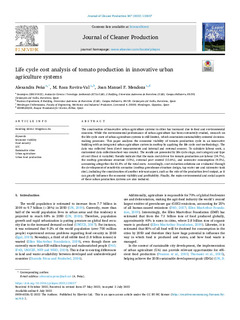
Title
Life cycle cost analysis of tomato production in innovative urban agriculture systemsxmlui.dri2xhtml.METS-1.0.item-contributorOtherinstitution
https://ror.org/052g8jq94https://ror.org/01cc3fy72
Version
http://purl.org/coar/version/c_970fb48d4fbd8a85
Rights
© 2022 The AuthorsAccess
http://purl.org/coar/access_right/c_abf2Publisher’s version
https://doi.org/10.1016/j.jclepro.2022.133037Published at
Journal of Cleaner Production Vol. 367. Artículo 133037. September, 2022Publisher
ElsevierKeywords
Economic viability
Food security
LCC
Sustainable cities ... [+]
Food security
LCC
Sustainable cities ... [+]
Economic viability
Food security
LCC
Sustainable cities
Urban agriculture
Urban food production [-]
Food security
LCC
Sustainable cities
Urban agriculture
Urban food production [-]
Abstract
The construction of innovative urban agriculture systems in cities has increased due to food and environmental concerns. While the environmental performance of urban agriculture has been extensively s ... [+]
The construction of innovative urban agriculture systems in cities has increased due to food and environmental concerns. While the environmental performance of urban agriculture has been extensively studied, research on the life cycle costs of urban agriculture systems is still limited, which constraints sustainability-oriented decision-making processes. This paper analyses the economic viability of tomato production cycle in an innovative building with an integrated urban agriculture system in rooftop by applying the life cycle cost methodology. The data was collected from direct measurements and internal and external sources. To calculate labour costs, a customised data collection sheet was created. The results are presented by life cycle stage, cost category and type of cost (fixed & variable). Results indicate that the main cost drivers for tomato production are labour (24.7%), the rooftop greenhouse structure (15%), external pest control (12.6%), and rainwater consumption (9.5%), accounting altogether for 61.8% of the total costs. Accordingly, cost reduction solutions are evaluated through the development of sensitivity scenarios (rooftop greenhouse structure design, tap water use and rainwater tank size), including the consideration of another relevant aspect, such as the role of the production level output, as it can greatly influence the economic viability and profitability. Finally, the main environmental and social aspects of these urban production systems are also included. [-]
xmlui.dri2xhtml.METS-1.0.item-sponsorship
Gobierno de Españaxmlui.dri2xhtml.METS-1.0.item-projectID
info:eu-repo/grantAgreement/GE/Programa Estatal de Investigación, Desarrollo e Innovación Orientada a los Retos de la Sociedad AEI/FEDER, UE. CTM2016-75772-C3-1-R/ES/Invernaderos integrados en azoteas: simbiosis de energía, agua y emisiones de co2 con el edificio ‐ Hacia la seguridad alimentaria urbana en una economía circular/Fertilecity IICollections
- Articles - Engineering [684]
The following license files are associated with this item:






















